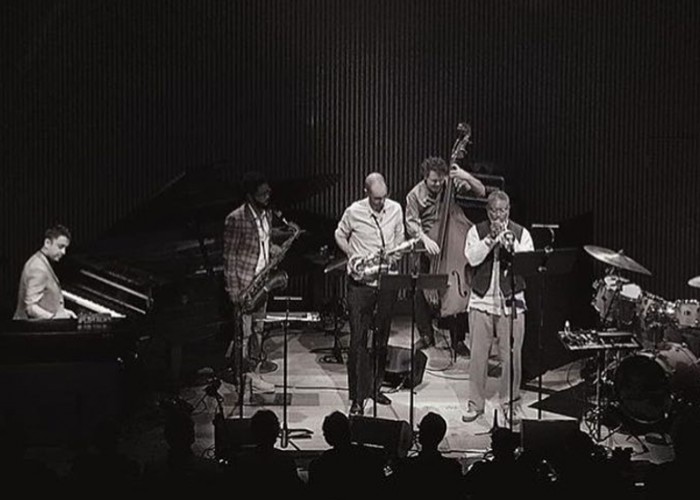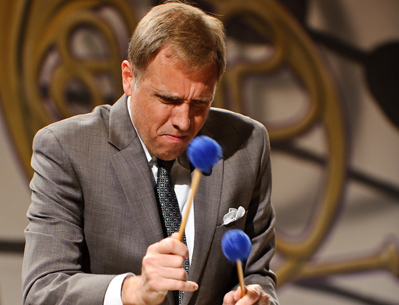Dec 9, 2025 12:28 PM
In Memoriam: Gordon Goodwin, 1954–2025
Gordon Goodwin, an award-winning saxophonist, pianist, bandleader, composer and arranger, died Dec. 8 in Los Angeles.…

Pianist Vijay Iyer performed in a variety of settings, including in this sextet, during a four-day showcase at SFJAZZ in January.
(Photo: Ross Eustis)Pianist, composer, bandleader and educator Vijay Iyer returned to San Francisco late in January for the second time in two years as a part of his stint as a SFJAZZ resident artistic director.
The disparate musical settings he performed in showcased a diverse aesthetic during four nights of shows.
On Thursday, Jan. 18, he presented a series of duo piano performances with Kris Davis and Craig Taborn. The next night, Iyer played with his trio, which includes double bassist Stephan Crump and drummer Marcus Gilmore. His sextet—Friday’s trio plus cornetist Graham Haynes, tenor saxophonist Mark Shim and alto saxophonist Steve Lehman—played Saturday, Jan. 20. Thums Up, Iyer’s new super-group that combines spoken word, sung lyrics and some electric instruments, made its West Coast debut during the series’ closing night.
Geri Allen, who died June 27, originally was scheduled to perform the first evening with Iyer and Taborn. Instead, Iyer and Mount Allen, Geri’s brother and SFJAZZ director of operations, made introductory remarks, and photos of the late pianist were projected above the bandstand throughout the evening.
The first half of the program featured Iyer and Davis, and then Davis and Taborn, facing one another while playing interlocking grand pianos. Each pair performed extended improvisations, unfolding slowly over time, as the partners effortlessly switched lead and accompanying roles while dipping in and out of a broad range of styles—fluttering sheets of harp-like arpeggios and glissandos, percussive clusters of atonal chords and stride-inspired passages.
Saturday’s sextet show was accompanied by the creations of San Francisco-based contemporary visual artist Chiraag Bhakta. Gilmore performing meant that he and cornetist Haynes, his uncle, could enjoy a familial, as well as musical connection on stage.
Speaking at both the beginning and end of the night, Iyer pointed out that his February 2017 at SFJAZZ run happened just after President Donald Trump took office. He acknowledged that the past year had brought about much change, both progressive and regressive, this most recent SFJAZZ appearance occurring just after the second annual Women’s March.
The sextet, which has been playing together since 2011, sounded simpatico Saturday on its opening composition, “Into Action” from 2017’s Far From Over (ECM). Iyer started his original piece unaccompanied, as he did for each number, before the frontline joined in for the brawny theme. Shim’s playing almost had a baritone saxophone-like presence and matched up with Gilmore’s muscular and steady playing.
When Haynes incorporated electronics that looped his unruffled lines, Iyer responded in kind by playing the Fender Rhodes adjacent to the grand piano and adjusting an effects box that sat atop the electric keyboard. Lehman often added subtle trills that illuminated thicker passages. Crump, in turn, provided a flexible yet reliable through line for Iyer’s trio, quintet, sextet and large ensemble, the latter having performed in 2017 and at this more recent show.
A highlight of the shorter, second Saturday set was “Nope,” the organically funky Far From Over number that found Iyer moving from Rhodes to piano. For the unannounced concluding piece, he and Crump engaged in a duo conversation before the horns and drums joined in. The bandleader concluded the night thoughtfully, post-band introductions, with a searching solo piano coda.
With his working sextet, Iyer was able to stretch out with likeminded bandmates while frequently playing the role of accompanist. Witnessing him in lean piano duos on Thursday and as a member of the rhythm section, supporting three horn players two nights later, offered listeners a full appreciation of his considerable growth and accomplishments as an instrumentalist, leader and collaborator. DB

Goodwin was one of the most acclaimed, successful and influential jazz musicians of his generation.
Dec 9, 2025 12:28 PM
Gordon Goodwin, an award-winning saxophonist, pianist, bandleader, composer and arranger, died Dec. 8 in Los Angeles.…

Belá Fleck during an interview with Fredrika Whitfield on CNN.
Jan 13, 2026 2:09 PM
The fallout from the renaming of the John F. Kennedy Center for the Performing Arts to include President Donald…

Flea has returned to his first instrument — the trumpet — and assembled a dream band of jazz musicians to record a new album.
Dec 2, 2025 2:01 AM
After a nearly five-decade career as one of his generation’s defining rock bassists, Flea has returned to his first…

Dec 11, 2025 11:00 AM
DownBeat presents a complete list of the 4-, 4½- and 5-star albums from 2025 in one convenient package. It’s a great…

Vibraphonist Chuck Redd found himself in the midst of a political firestorm after canceling his gig Dec. 24 at the newly renamed Trump Kennedy Center.
Jan 6, 2026 2:32 AM
The Board of Trustees at Washington, D.C.’s Kennedy Center for the Performing Arts voted on Dec. 18 to rename the…